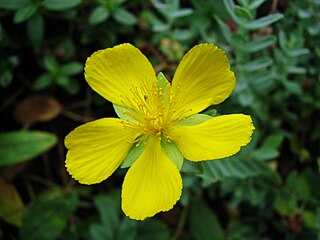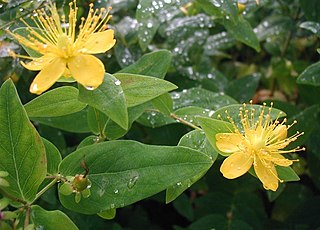
Hypericum perforatum, commonly known as St John's wort, is a flowering plant in the family Hypericaceae. It is a perennial plant that grows up to one meter tall, with many yellow flowers that have clearly visible black glands around their edges, long stamens, and three pistils. Probably a hybrid between the closely related H. attenuatum and H. maculatum that originated in Siberia, the species is now found worldwide. It is native to temperate regions across Eurasia and North Africa, and has been introduced to East Asia, Australia, New Zealand, and parts of North and South America. In many areas where it is not native, H. perforatum is considered a noxious weed. It densely covers open areas to the exclusion of native plants, and is poor grazing material. As such, methods for biocontrol have been introduced in an attempt to slow or reverse the spread of the species.

Hypericum is a genus of flowering plants in the family Hypericaceae. The genus has a nearly worldwide distribution, missing only from tropical lowlands, deserts and polar regions. Many Hypericum species are regarded as invasive species and noxious weeds. All members of the genus may be referred to as St. John's wort, and some are known as goatweed. The white or pink flowered marsh St. John's worts of North America and eastern Asia are generally accepted as belonging to the separate genus TriadenumRaf.

Hypericum androsaemum, the shrubby St. John's wort, is a flowering plant in the family Hypericaceae. Commonly called tutsan or sweet-amber, the species is cultivated as an ornamental plant because of its striking red-tinted foliage, bright yellow petals, and its large clusters of fruit. Cultivars like 'Albury Purple' and 'Golden Tutsan' which have leaves with more pronounced purple and golden coloring, respectively.

Hypericum olympicum, commonly known as the Mount Olympus St. John's wort, is a species of flowering plant in the family Hypericaceae found in the Balkans and Turkey and introduced to western Europe. It has been widely cultivated for centuries because of its large, showy flowers, which are far larger than those of most other species in Hypericum.

Hypericum bupleuroides is a species of perennial flowering plant in the St John's wort family, Hypericaceae. It grows 45–80 centimeters tall, and notably has perfoliate leaves that are fused at the stem. It has pyramid-shaped flower clusters of 1 to 25 flowers with yellow petals in a star-shaped arrangement. The species is found along the Black Sea coast near the Turkish–Georgian border. Hypericum bupleuroides has a small distribution and specific habitat requirements that make it vulnerable to environmental pressures.

Hypericum hircinum is a species of perennial flowering plant in the St John's wort family, Hypericaceae. It is known as goat St John's wort and stinking tutsan; both names refer to the plant's distinctive odor. The species is a bushy shrub that can grow up to 1.5 meters tall, is many-stemmed, and has golden yellow flowers with conspicuous stamens. The plant has been well-documented in botanical literature, with mentions dating back to at least 1627. Carl Linnaeus described H. hircinum several times, including in his 1753 Species Plantarum which established its binomial. At one point the plant was placed into the defunct genus Androsaemum, but it was returned to Hypericum by Norman Robson in 1985.

Hypericum japonicum, known as matted St. John's-wort, is an annual herbaceous flowering plant in the St. John's wort family Hypericaceae, in Hypericum sect. Trigynobrathys.

Hypericum huber-morathii is a flowering plant in the family Hypericaceae, section Adenosepalum, and the type species of the Hypericum huber-morathii group.

Hypericum virginicum, the marsh St. Johns-wort or Virginia marsh St. Johnswort, is a species of flowering plant in the family Hypericaceae. It is native to the central and eastern United States and eastern Canada.

Hypericum coris, the heath-leaved St. John's wort, also called yellow coris, is a species of flowering plant in the family Hypericaceae, and is the type species of sect. Coridium. It is a low shrub, and it is found in Switzerland and northwestern Italy. The species has been a popular garden plant since the 18th century, valued for its long flowering period and for how well it adapts to cultivation.
Hypericum antiquum is an extinct species of the genus Hypericum that was present during the Eocene epoch. The species' fossils are the oldest collected of Hypericum, and it is believed that the species is the common ancestor of the tribe Hypericeae. Fossil seeds have been found in Russia, and the predicted paleoregion of the species stretched across Eurasia. It is theorized that one factor leading to the species' extinction is a global cooling at the end of the Eocene that removed much of its habitat.

Hypericum tubulosum, the lesser marsh St. Johnswort or southern marsh St. John's-wort, is a species of flowering plant in the family Hypericaceae. Formerly classified as synonym Triadenum tubulosum, the species is found across the Southern United States and Midwest. It grows in wetlands such as bogs and floodplains.

Hypericum heterophyllum is a flowering plant in the Hypericaceae family and is the only species in Hypericum sect. Heterophylla.
Hypericum holyi is an extinct species of the genus Hypericum that was present from the Lower Miocene to the Upper Miocene. Fossil seeds of the species have been found in Central Europe in general and Central Jutland, Denmark, in particular.
Hypericum septestum is an extinct species of the genus Hypericum that was present during the Oligocene and Miocene epochs. Its holotype is a fossil seed from the Lower Oligocene that was collected in Western Siberia in 1965, and fossils of the species has also been found in other parts of Russia and in the Czech Republic.
Hypericum miocenicum is an extinct species of the genus Hypericum. Seeds of the species have been recorded from the Late Oligocene in Germany, the Late Miocene in Poland (Poznan), and the Pliocene in Germany (Thuringia). It differs from H. septestum, a more frequently found Hypericum paleospecies, by its thinner foveole walls and the shape of its surface cells, which are more rectangular.
Hypericum foveolatum is an extinct species of the genus Hypericum. The paleospecies is known from more recent fossils than many other Hypericum specimens, with fossilized seeds from the Pliocene epoch being found in Russia and Belarus. These seeds have been compared to numerous extant species, including H. elegans, H. tetrapterum, H. attenuatum, H. kamtschaticum, H. yezoënse, H. nudiflorum, and H. microsepalum. However, none of these similar species have the exact same kind of testa surface cells as H. foveolatum.
Hypericum danicum is an extinct species of flowering plant in the family Hypericaceae. The species is known from a fossil seed found among other Hypericum seeds in Italy, and is dated to the Pliocene. It has also been recorded several times from the Søby region of Denmark, also by discovered fossil seeds.
Hypericum bornense is an extinct species of flowering plant in the family Hypericaceae. It was described by botanist D.H. Mai in 1978, based on fossil seed remains from the Early to Late Oligocene found in Saxony, Germany, and Tomsk, Russia. It is likely that the species' habitat was that of a mixed-mesophytic forest.










